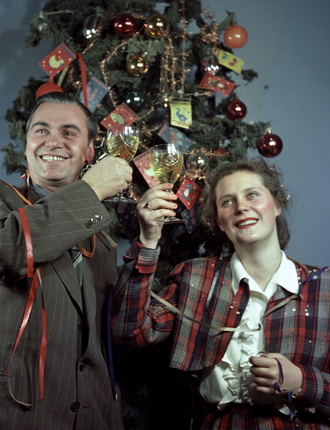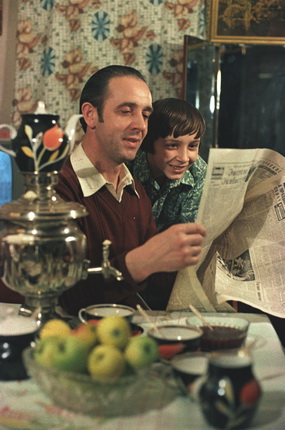Ogoniok. Life as a holiday







Yakov Ryumkin. Happy New Year, Comrades! 1954. Ogoniok archive
Mikhail Savin. Polisher at the Lyudinovo Diesel Locomotive Plant and delegate to the 26th Congress of the Communist Party of the Soviet Union Gennady Petrukhin with his son Alexander. Kaluga region. 1981. Ogoniok archive
Yakov Ryumkin. A bumper wheat harvest in the Novo-Alexandrovsk district of Stavropol region. Collective farm worker Anastasia Nikolaevna "hugs" the grain. 1951. Ogoniok archive
Yakov Ryumkin. Cosmonaut Yuri Gagarin at home with his wife, Valentina. 1962. Ogoniok archive
Dmitry Baltermants. Young Leninists Alyosha Pilyaev and Igor Usakov. Moscow. 1961. Ogoniok archive
Mikhail Savin. Review by young actors of the Yanka Kupala Belorussian Drama Theatre. Minsk. 1953. Ogoniok archive
Nikolai Drachinsky. The high-altitude skating rink in Alma-Ata. Spectators. 1955. Ogoniok archive
-
National Museum of the Republic of Komi,
Moscow 14.12.2018 — 18.02.2019 -
Multimedia Art Museum,
Moscow 18.12.2014 — 15.02.2015
About
LIFE AS A HOLIDAY
The exhibition ‘Life as a holiday’ consists of archive photographs from Ogoniok magazine dating from the 1930s to the 1970s.
Ogoniok was an illustrated magazine from its foundation in 1899. It was the television of the pre-television age, around which the whole family gathered. After a break in publication during the years of the revolution, Ogoniok relaunched in 1923 and by 1925 had a print run of 500,000.
At this time there was a real boom in photography. It became a powerful visual weapon for the young Soviet state. The best Soviet photographers worked with Ogoniok, including Arkady Shaikhe...
MoreLIFE AS A HOLIDAY
The exhibition ‘Life as a holiday’ consists of archive photographs from Ogoniok magazine dating from the 1930s to the 1970s.
Ogoniok was an illustrated magazine from its foundation in 1899. It was the television of the pre-television age, around which the whole family gathered. After a break in publication during the years of the revolution, Ogoniok relaunched in 1923 and by 1925 had a print run of 500,000.
At this time there was a real boom in photography. It became a powerful visual weapon for the young Soviet state. The best Soviet photographers worked with Ogoniok, including Arkady Shaikhet, Eleazar Langman, Emmanuil Evzerikhin, Vsevolod Tarasevich, Isaak Tunkel, Mikhail Savin, Eduard Ettinger, Galina Sanko, Dmitry Debabov, Semyon Fridlyand, Lev Borodulin, Lev Sherstennikov and, of course, Dmitry Baltermants. He began to work at Ogoniok in 1946 and then, from 1965 to 1990, was head of the magazine’s photography department.
The work of this glittering photographic galaxy is the basis of the exhibition ‘Life as a holiday’, which marks 115 years since the magazine’s foundation.
The tradition of photography in Ogoniok was largely formed by the history and ideology of the country. Photography is the mirror of the age, but the amalgam of that mirror changes with the times and is defined by them. From the 1930s photography, like all other art forms, was obliged to observe the tenets of socialist realism. Photography was not to depict life ‘as it is’. It was much more important to show ‘how things should be’. In photography textbooks of that time attention was focused on the rules of staging, on directing seemingly objective reporting. Each posed photograph became a political expression, simultaneously both a product and a tool of ideological work. Using their great talent photographers constructed an image of the happiest person in the happiest country on earth. The triumphs of collective labour in the fields, in the factories and on building sites, pictures of the new daily life, scenes of carefree childhood and well-deserved leisure — Ogoniok’s photographs breathe a holiday atmosphere or its anticipation. Together they produce a mythological pattern of collective happiness. Ogoniok’s visual canon took its definitive form in the mid-1950s, at the peak of the publication’s fame as an illustrated magazine. In the ‘thaw’ of the 1960s, individualised happiness started to appear through the shroud of the collective holiday. Facial expressions, poses, subjects and tone changed. With the arrival of the stagnation years of the 1970s holiday ceased to be the main theme of Soviet photography. For this reason photographs from these two decades do not dominate the exhibition but demonstrate the aesthetics and the ideological direction of the previous epoch.
The works of Soviet photographers featured in the exhibition both charm and, with the passing of the years, force one to think about our past, present and future. Today Ogoniok is part of the new media space. Reality looks out of its pages at us, and there is a place for more than holiday. One thing remains unchanged — Ogoniok’s place in the life of this huge country and in the history of Russian photojournalism.
BUILDING THE OGONIOK PHOTO ARCHIVE TOGETHER
The exhibition features some photographs by unknown authors. The history of the Ogoniok photo archive is part of the history of our country, with its shocks, losses and unknown heroes. If you have information about the photographers please write to photo@kommersant. ru or advise the museum administrator. Together we can make Ogoniok’s unique archive more comprehensive, preserving the photographers’ names for future generations.
Museum collaborations
For further enquiries please contact
Julia Beigun
+7 (495) 637-11-22 ext. 218
beigun@mdf.ru


